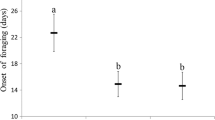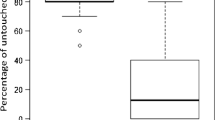Abstract
The aim of this study was to investigate an underlying mechanism of the apparent tolerance of Africanized honey bees (AHB) to Varroa jacobsoni mites in Mexico. This was achieved by conducting the first detailed study into the mites' reproductive biology in AHB worker cells. The data was then compared directly with a similar study previously carried out on European honey bees (EHB) in the UK. A total of 1071 singly infested AHB worker cells were analyzed and compared with the data from 908 singly infested EHB worker cells. There was no significant difference between the number of mother mites dying in the cells (AHB = 2.0%, EHB = 1.8%); the mean number of eggs laid per mite (AHB = 4.86, EHB = 4.93); the number of mites producing no offspring (AHB = 12%, EHB = 9%); and developmental times of the offspring in worker cells of AHB and EHB. However, there was a major difference between the percentage of mother mites producing viable adult female offspring (AHB = 40%, EHB = 75%). This was caused by the increased rate of mite offspring mortality suffered by the first (male) and second (female) offspring in AHB worker cells. Therefore, only an average of 0.7 viable adult female offspring are produced per mite in AHB, compared to 1.0 in EHB.
Similar content being viewed by others
References
Blum, R. 1989. Reproduction of Varroa in relation to protein supply of the honey bee colonies. Apidologie 20, 509–512.
Boot, W.J., Tan, N.Q., Dien, P.C., Huan, L.V., Dung, N.V., Long, L.T. and Beetsma. J. 1997. Reproductive success of Varroa jacobsoni in brood of its original host, Apis cerana, in comparison to that of its new host, A. mellifera (Hymenoptera: Apidae). Bull. Entomol. Res. 87, 119–126.
Corrêa-Marques, M.H. and De Jong, D. 1998. Uncapping of worker bee brood, a component of the hygienic behavior of Africanized honey bees against the mite Varroa jacobsoni Oudemans. Apidologie 29, 283–289.
Daly, H.V. and Balling, S.S. 1978. Identification of Africanized honey bees in the Western Hemisphere by discriminant analysis. J. Kans. Entomol. Soc. 51, 857–869.
De Jong, D. 1990. Mites: Varroa and other parasites of brood. In: Honey Bee Pests, Predators, and Diseases, R.A. Morse and R. Nowogrodzki (eds), pp. 200–218. Comstock Publishing Associates, Ithaca, New York.
De Jong, D. 1996. Africanized honey bees in Brazil, forty years of adaptation and success. Bee World 77, 67–70.
De Jong, D., Gonçalves, L.S. and Morse, R.A. 1984. Dependence on climate of the virulence of Varroa jacobsoni. Bee World 65, 117–121.
Donzé, G. and Guerin, P.M. 1997. Time-activity budgets and space structuring by the different life stages of Varroa jacobsoni in capped brood of the honey bee Apis mellifera. J. Insect Behaviour 10, 371–393.
Guzman, L.I. de, Rinderer, T.E. and Stelzer, J.A. 1999. Occurrence of two genotypes of Varroa jacobsoni Oud. in North America. Apidologie 30, 31–36.
Guzman-Novoa, E., Sanchez, A., Page, Jr., R.E. and Garcia, T. 1996. Susceptibility of European and Africanized honey bees (Apis mellifera L.) and their hybrids to Varroa jacobsoni. Apidologie 27, 93–103.
Ifantidis, M.D. 1983. Ontogenesis of the mite Varroa jacobsoni in worker and drone brood cells. J. Apicult. Res. 23, 227–233.
Martin, S.J. 1994. Ontogenesis of the mite Varroa jacobsoni Oud. in worker brood of the honey bee Apis mellifera L. under natural conditions. Exp. Appl. Acarol. 18, 87–100.
Martin, S.J. 1998. A population model for the ectoparasitic mite Varroa jacobsoni in honey bee (Apis mellifera) colonies. Ecological Modelling 109, 267–281.
Martin, S.J. and Kemp, D. 1997. Average number of reproductive cycles performed by Varroa jacobsoni in honey bee (Apis mellifera) colonies. J. Apicult. Res. 36, 113–123.
Martin, S.J., Holland, K. and Murray, M. 1997. Non-reproduction in the honey bee mite Varroa jacobsoni. Exp. Appl. Acarol. 21, 539–549.
Medina L.M. 1998. Frequency and infestation levels of the mite Varroa jacobsoni Oud. in managed honey bee (Apis mellifera L.) colonies in Yucatan, Mexico. Am. Bee J. 138, 125–127.
Message, D. and Gonçalves, L.S. 1995. Effect of the size of worker brood cells of Africanized honey bees on infestation and reproduction of the ectoparasitic mite Varroa jacobsoni Oud. Apidologie 26, 381–386.
Moretto, G., Gonçalves, L.S. and De Jong, D. 1993. Heritability of Africanized and European honey bee defensive behavior against the mite Varroa jacobsoni. Braz. J. Genet. 16, 71–77.
Moretto, G., Gonçalves, L.S., De Jong, D. and Bichuette, M.Z. 1991. The effects of climate and bee race on Varroa jacobsoni Oud infestation in Brazil. Apidologie 22, 197–203.
Moretto, G., Pilatti, A., Cassini, F.L., Dellatorre, S.F., Bonetto, L.C. and Puttkammer, E. 1995. Levels of infestation by the mite Varroa jacobsoni in colonies of Apis mellifera honey bees in the state of Santa Catarina, Brazil. Apiacta 30, 9–12.
Moretto, G., Gonçalves, L.S. and De Jong, D. 1997. Relationship between food availability and the reproductive ability of the mite Varroa jacobsoni in Africanized bee colonies. Am. Bee J. 137, 67–69.
Moritz, R.F.A. 1985. Heritability of the post capping stage in Apis mellifera and its relation to varroatosis resistance. J. Hered. 76, 267–270.
Quezada-Euan, J.J., Echazarreta, C.M. and Paxton, R.J. 1996. The distribution and range expansion of Africanized honey bee (Apis mellifera) in the state of Yucatan, Mexico. J. Apic. Res. 35, 85–95.
Rodriguez, S.R., Moro, J.M. and Otero, G.C. 1992. Varroa found in Mexico. Am. Bee. J. 132, 728–729.
Rosenkranz, P. and Engels, W. 1994. Infertility of Varroa jacobsoni females after invasion into Apis mellifera worker brood as tolerance factor against varroatosis. Apidologie 25, 402–411.
Vandame R., 1996. Importance of host hybridization in the tolerance to a parasite. Example of the parasitic mite Varroa jacobsoni, in colonies of European and Africanized honey bees Apis mellifera, in humid tropical climate of Mexico. Ph.D. Thesis. Universite Claude Bernard, Lyon, France, pp. 111 (in French).
Author information
Authors and Affiliations
Rights and permissions
About this article
Cite this article
Medina, L.M., Martin, S.J. A Comparative Study of Varroa Jacobsoni Reproduction in Worker Cells of Honey Bees (Apis Mellifera) in England and Africanized Bees in Yucatan, Mexico. Exp Appl Acarol 23, 659–667 (1999). https://doi.org/10.1023/A:1006275525463
Issue Date:
DOI: https://doi.org/10.1023/A:1006275525463




